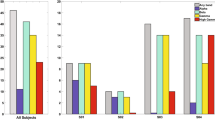Abstract
We describe the procedure with which cortical potential responses are evoked by a stimulation of the anal canal to assess the integrity of its sensory pathways. These potentials were recorded in 66 patients. In 44 patients, a cortical evoked response was obtained with a succession of positive and negative peaks, W shaped (35 cases) or V shaped (nine cases). In seven cases, cortical responses were interpreted differently by two independent observers. In these seven patients, such differences could be explained by an insufficient amplification of the recorded electrical waves recorded on paper (<10 mm). Fifteen patients gave no cortical response. Eight had a neurologic disease that could explain the lack of response. In the seven others, the absence of response was considered as false negative, but six of these stimulations had been carried out during the first part of the study. There is some evidence that cortical evoked potentials may be obtained after an electrical stimulation of the anal canal, but a training period seems necessary to master the technique and obtain reproducible and recognizable responses.
Similar content being viewed by others

References
Snooks SJ, Swash M. Nerve stimulation techniques. A. Pudendal nerve terminal motor latency, and spinal stimulation. In: Henry MM, Swash M, eds. Coloproctology and the pelvic floor. Pathophysiology and management. 1st ed. London: Butterworths, 1985:112–24.
Weber J, Grise P, Roquebert M,et al. Radiopaque markers transit and anorectal manometry in 16 patients with multiple sclerosis and urinary bladder dysfunction. Dis Colon Rectum 1987;30:95–100.
Beuret-Blanquart F, Weber J, Gouverneur JP, Demangeon S, Denis P. Colonic transit time and anorectal manometric anomalies in 19 patients with complete transection of the spinal cord. J Auton Nerv Syst 1990;30:199–208.
Merton PA. Nerve stimulation techniques. B. Electrical stimulation through the scalp of pyramidal tract fibres supplying pelvic floor muscles. In: Henry MM, Swash M, eds. Coloproctology and the pelvic floor. Pathophysiology and management. 1st ed. London: Butterworths, 1985:125–8.
Opsomer RJ, Caramia MD, Zarola F, Pesce F, Rossini PM. Neurophysiological evaluation of central-peripheral sensory and motor pudendal fibres. Electroencephalogr Clin Neurophysiol 1989;74:260–70.
Burke D, Skuse NF, Lethlean AK. Cutaneous and muscle afferent components of the cerebral potential evoked by electrical stimulation of human peripheral nerves. Electroencephalogr Clin Neurophysiol 1981;51:579–88.
Kaplan PE. Somatosensory evoked responses obtained after stimulation of the pelvic and pudendal nerves. Electromyogr Clin Neurophysiol 1983;23:99–102.
Badr GG, Fall M, Carlsson C-A, Lindström L, Friberg S, Ohlsson B. Cortical evoked potentials obtained after stimulation of the lower urinary tract. J Urol 1984;131:306–9.
Sarica Y, Karacan I, Thornby JI, Hirshkowitz M. Cerebral responses evoked by stimulation of vesicourethral junction in man: methodological evaluation of monopolar stimulation. Electroencephalogr Clin Neurophysiol 1986;65:130–5.
Sarica Y, Karacan I. Cerebral responses evoked by stimulation of the vesico-urethral junction in normal subjects. Electroencephalogr Clin Neurophysiol 1986;65:440–6.
Sarica Y, Karacan I. Electrophysiological correlates of sensory innervation of the vesico-urethral junction and urethra in man. Neurourol Urodyn 1988;6:477–84.
Hansen MV, Ertekin C, Larsson L-E. Cerebral evoked potentials after stimulation of the posterior urethra in man. Electroencephalogr Clin Neurophysiol 1990;77:52–8.
Collet L, Meunier P, Duclaux R, Chery-Croze S, Falipou P. Cerebral evoked potentials after endorectal mechanical stimulation in humans. Am J Physiol 1988;254:G477–482.
Bielefeldt K, Enck P, Erckenbrecht JF. Sensory and motor function in the maintenance of anal continence. Dis Colon Rectum 1990;33:674–8.
Opsomer RJ, Guerit JM, Wese FX, Van Cangh PJ. Pudendal cortical somatosensory evoked potentials. J Urol 1986;135:12l6–8.
Vodusek DB. Pudendal SEP and bulbocavernosus reflex in women. Electroencephalogr Clin Neurophysiol 1990;77:134–6.
Rogers J, Henry MM, Misiewicz JJ. Combined sensory and motor deficit in primary neuropathic faecal incontinence. Gut 1988;29:5–9.
Duthie HL, Bennett RC. The relation of sensation in the anal canal to the functional anal sphincter: a possible factor in anal continence. Gut 1963;4:179–82.
Author information
Authors and Affiliations
Additional information
Supported by a grant from the INSERM, 101 rue de Tolbiac 75654 Paris Cedex 13.
About this article
Cite this article
Delechenault, P., Leroi, A.M., Bruna, T. et al. Cerebral potentials evoked by electrical stimulation of the anal canal. Dis Colon Rectum 36, 55–60 (1993). https://doi.org/10.1007/BF02050302
Issue Date:
DOI: https://doi.org/10.1007/BF02050302



